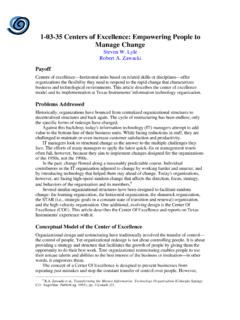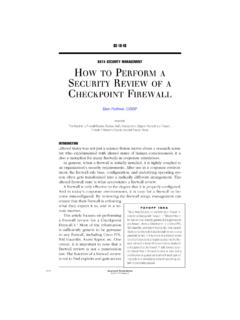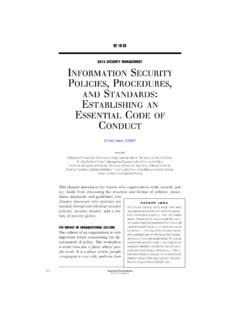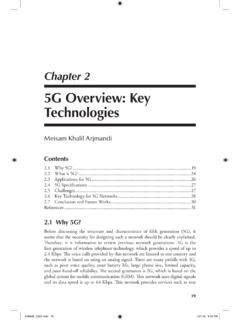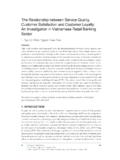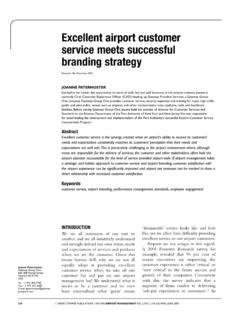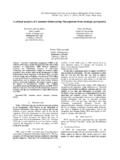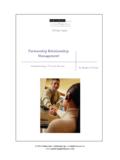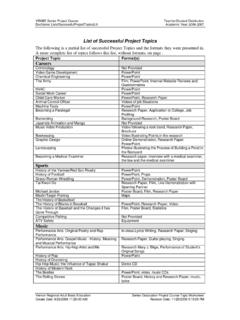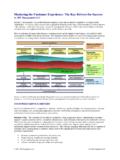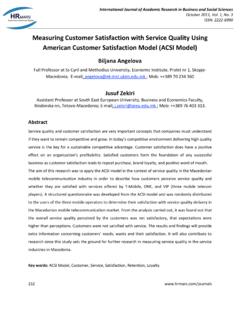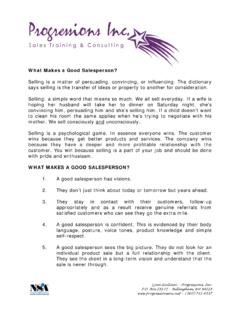Transcription of Customer Relationship Management (CRM) System
1 67 Chapter 2 Customer Relationship Management (CRM) SystemWhat is a Customer Relationship Management (CRM) System ? Not only is there little agreement on what it really stands for, there is even less agreement on what constitutes a CRM System , how it should be used, the potential of profitability gain, the impact on Customer loyalty, the costs involved, the personnel needed, and the training needed for the CRM personnel. CRM System characteristics are not limited to the CRM products and tools that are currently available in the market, and CRM is certainly not a technique or methodology. There is every reason to believe that the boundaries described for CRM in this book will be constantly enlarging in the coming years (see Section Anatomy of a CRM System ). introduction to Customer Relationship Management (CRM) SystemsNotwithstanding all these caveats, a CRM System could be defined reasonably as follows: A Customer Relationship Management (CRM) System is a suite of pre-engineered, ready-to-implement, integrated application modules that focus on automating and optimizing all Customer -centric and Customer -responsive functions sales, marketing, service, and support of an enterprise and possessing the flexibility for configuring, customizing, and personalizing dynamically the delivered functionality of the package, through any channel of interaction, to suit even the specific requirements of an individual Customer .
2 CRM enables an enterprise to operate as a Relationship -based, information-driven, integrated, enterprise-wide, process- oriented, real-time, and intelligent Customer -centric and Customer -responsive System applications provide the framework for executing the best practices in Customer -facing activities; it provides a common platform for Customer communication and inter-action. The use of CRM System applications helps in improving Customer responsiveness and also provides a comprehensive view of the entire Customer Life Cycle. With reference to Figure , From "Implementing SAP CRM: The Guide for Business and Technology Managers" by Vivek Kale ISBN 978-1-4822-3142-7. 2015 by Taylor & Francis Group, LLC68 Implementing SAP CRMone can state that CRM Systems, like CRM, are useful to companies that have customers with large variability both in their needs and their value to the company s CRM System like SAP CRM can provide this comprehensiveness and flexibility because at the heart of the System resides a CASE-like repository that stores all details of these predeveloped applications.
3 These details include every single data objects, business objects, and user-interface (UI) programs that are used by the complete System . It also has additional support subsystems that help it to manage, secure, and maintain the operations of this package on a day-to-day packages, and especially enterprise-wide solutions such as CRM systems, are considered as the best approach for confronting the software crisis of the 1980s (see the following note on customized vs. packaged solutions). This was because 1. CRM Systems ensure better validation of user requirements directly by the user. 2. CRM Systems ensure consistent quality of delivered functionality. 3. CRM Systems provide a cohesive and integrated information System architecture. 4. CRM Systems ensure a fair degree of standardization.
4 5. CRM Systems provide a consistent and accurate documentation of the System . 6. CRM Systems provide outstanding quality and productivity in the development and main-tenance of the a decade later, as companies are reporting their experiences in implementing a CRM System , a base of experience seems to support the fact that companies that plan and manage the use of CRM System are usually successful. Today, the recognized Management decision is not whether to use CRM System , but rather when to use CRM System and which CRM System to use. As we go through this book, it will become evident that SAP CRM is the best-of-breed product in this success of CRM Systems is based on the principle of reusability. The origin of reusability goes back almost to the beginning of the computer era, when it was recognized that far too much program code was being written and rewritten repeatedly and uneconomically.
5 Very soon, most of the programming languages provided for routines or packets of logic that could be reused multiple times within individual programs or even by a group of programs. Databases enabled the reuse of data, resulting in a tremendous surge in programmer productivity. Similarly, networks permitted reuse of the same programs on different terminals or workstations at different Systems, like ERPs, extended the concept of reusability to the functionality provided by a System . For instance, SAP CRM was based on the essential commonality observed in the function-ing of companies within an industry. SAP built a reusable library of normally required processes in a particular industry, and all that implementing SAP CRM customers had to do was to select from this library all those processes that were required by their company.
6 From the project effort and cost that were essential for the development and implementation using the traditional software develop-ment life cycle (SDLC), CRM reduced the project effort and cost to that associated only with the implementation phase of the SDLC. Even though the cost of implementing a CRM System like SAP CRM might seem higher than that of traditional System , the CRM System gets implemented sooner and therefore starts delivering all of its benefits much earlier than the traditional there have not been any published results as yet, it has become an accepted fact that enterprises that implemented CRM systems for only a part of their organizations, or for only a few select functions within their organizations, did not benefit greatly. CRM Systems, like ERPs earlier, recognize the fact that business processes of an organization were much more fundamental than data characterizing various aspects of the organization.
7 Most importantly, CRM systems From "Implementing SAP CRM: The Guide for Business and Technology Managers" by Vivek Kale ISBN 978-1-4822-3142-7. 2015 by Taylor & Francis Group, LLCC ustomer Relationship Management (CRM) System 69elevated information systems from a mere enabler of the business strategy of an organization to a significant part of the business strategy , CRM Systems brought to an end the subsidiary and support role that IT had played throughout the last few decades. But in turn, the very nature of IS has also undergone a complete transformation. Implementing a CRM System within an enterprise is no longer a problem of technology; it is a business problem. CRM Systems have been the harbingers of a paradigm shift in the role of the IS/IT function within an enterprise.
8 This book was motivated by the need to address these fundamental changes in the very nature of IS/IT activity within an distinguishing characteristics of a CRM System are CRM System transforms an enterprise into an information-driven enterprise. CRM System fundamentally perceives an enterprise as a global enterprise. CRM System reflects and mimics the integrated nature of an enterprise. CRM System fundamentally models a process-oriented enterprise. CRM System enables the real-time enterprise. CRM System enables the intelligent enterprise. CRM System elevates IT strategy as a part of the business strategy. CRM System represents Advance on the approaches to Manufacturing Performance Improvement. CRM System represents the new Department Store model of implementing computerized systems. CRM System is a mass-user-oriented application CRM Transforms an Enterprise into an Information-Driven EnterpriseAll computerized systems and solutions in the past used past-facing information merely for the purpose of referrals and reporting only.
9 ERP, for the first time in the history of computerized systems, began treating information as a resource for the operational requirements of the enter-prise. But unlike the traditional resources, information resource as made available by CRMs (and ERPs) can be reused and shared multiply without dissipation or degradation. The impressive productivity gains resulting from the CRMs truthfully arise from the unique characteristic of CRMs (and, earlier, ERPs) to use information as an inexhaustible interactions, which are the mainstay of CRMs, create real-time organizational knowl-edge providing insights into the Customer behavior. CRMs enable an organization to use the real-time knowledge and information gained at any touch point to manage and synchronize the communica-tions and marketing messages it delivers to its customers in all its touch point have differentiated between the concepts of Customer Relationship Management (CRM) and Customer Relationship Management Systems (CRM Systems) that implement possibly a part of this holistic concept.
10 This book mainly relates to SAP CRM as a System to realize the CRM programs of a company; hereafter, for the sake of convenience, by CRM, we will usually refer to aspects of a comprehensive CRM Program that are embodied into a CRM System like SAP CRM implemented within the "Implementing SAP CRM: The Guide for Business and Technology Managers" by Vivek Kale ISBN 978-1-4822-3142-7. 2015 by Taylor & Francis Group, LLC70 Implementing SAP CRM Perceives an Enterprise as a Global EnterpriseIn these times of divestitures, mergers, and acquisitions, this is an important requirement. Unlike some of the earlier enterprise-wide solutions available on mainframes, CRM packages like SAP CRM cater to corporation-wide requirements even if an organization is involved in disparate businesses such as discrete industries (manufacturing, engineering, and so on), process industries (chemicals, paints, and so on), and service industries (banking, media, and so on).

